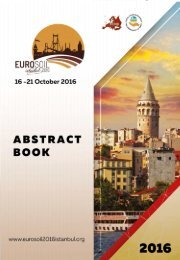Create successful ePaper yourself
Turn your PDF publications into a flip-book with our unique Google optimized e-Paper software.
140 Agricultural and Natural Research & Reviews
parameters were investigated. In the study, high and low-temperature exotherms
were determined in the primary buds, and the relationship between tolerance
levels was determined by lipid peroxidation, total carbohydrate, total watersoluble
protein, peroxidase, hydrogen peroxide, and siglent oxygen analyzes of
these buds (Rende et al., 2018). On the other hand, in a study in which the effect
of rapid temperature changes on frost resistance was tried to be determined, the
grape cultivar ‘Karaerik’ was used. Based on the results of the study, it was stated
that rapid temperature changes (4.00°C) changed cold hardiness in dormant
buds. To achieve consistent LTE results and reliability at DTA tests, it was
decided that buds should be brought into the lab by keeping the temperatures at
the sampling time, prepared for DTA analyzes at these temperatures, and starting
DTA analyzes from these temperatures is the right test (Kaya & Kose 2020).
In addition to these studies, an interesting study was conducted on whether
removing the first five leaves at the base of the shoot changes the bud cold
hardiness. The results showed that the adoption of defoliation in cool climates
has no adverse effects on the survival of basal buds, but may instead improve the
survival of apical ones is of particular interest concerning this grape cultivar with
poor basal bud fruitfulness (Kaya 2020). In the light of the above studies, we can
say that the LT 50
value of the dormant buds of the ‘Karaerik’ grape cultivar was
-18 o C, while the LT 100
values of the buds were determined as -25 o C.
2.4. Chemical properties
Sat et al., (2002) reported the suitability of canned and fresh (unprocessed)
‘Karaerik’ cultivar grape leaves to prepare Sarma, a traditional Turkish dish.
Based on the physical and chemical analysis findings, the results showed that
the quality of the ‘Karaerik’ leaves was better than the leaves of some grape
cultivars. The sensory evaluation also showed that ‘Karaerik’ grape cultivar was
the most suitable grape leaf for making Sarma food.
The physical, chemical, and phytochemical properties of the clones of the
‘Karaerik’ grape cultivar were examined and differences between clones were
determined in terms of these properties. Clone 30 in terms of cluster weight,
clone 23 for color characteristics, clone 13 and clone 15 for berry size and berry
width, clone 19 for the total soluble solids (TSS) content, clone 15 for berry
weight, clone 13 also for organic acid and clones 15 also for macro-micronutrient
content have been the prominent clones. Except for catechin, there also
was no difference in phenolic compound content between clones (Karadoğan &
Keskin 2017). In the study of Keskin (2018a), the trans-resverarol production
potential of ‘Karaerik’ clones ranged from 77.78 µg kg -1 to 57.01 µg kg -1 (fresh






